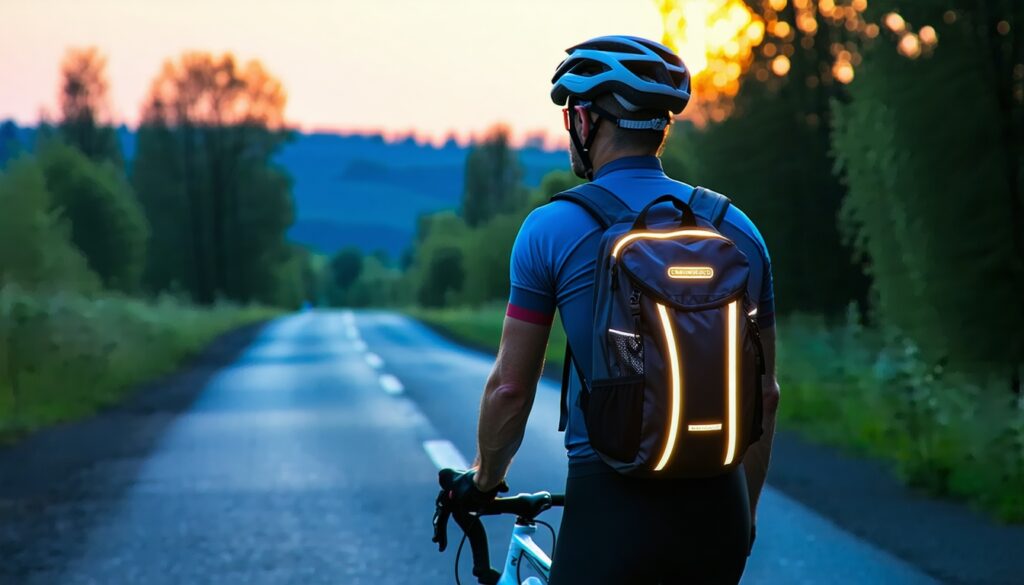Reflective Features That Every Cyclist Needs for Visibility

The Importance of Reflective Features
Visibility is crucial for cyclists, especially during low-light conditions such as dusk, dawn, or inclement weather. Reflective features are essential for enhancing this visibility and ensuring the safety of cyclists on the road.
Enhancing Visibility in Low-Light Conditions
The science behind reflective gear is straightforward — when light hits a reflective surface, it bounces back toward the source. This means that when a cyclist is wearing reflective gear and car headlights shine on it, the light reflects back towards the driver, making the cyclist more noticeable (Stio). Utilizing reflective material and bright colors can decrease the probability of accidents by over 50%, significantly improving safety for cyclists in low-light conditions.
| Light Source | Effect on Reflective Gear |
|---|---|
| Car Headlights | Light reflects back to driver |
| Street Lights | Enhances cyclist visibility |
| Flashlights | Useful during late-night rides |
Types of Reflective Gear for Cyclists
Cyclists have various options when it comes to reflective gear, each designed to enhance visibility from different angles:
| Reflective Gear Type | Description |
|---|---|
| Reflective Vests | Lightweight and breathable, providing 360° visibility. |
| Reflective Jerseys | Incorporate retroreflective technology for nighttime safety while maintaining performance. |
| Reflective Gloves | Ensures hand signals are easily visible by other road users. |
| Reflective Socks | Adds an extra layer of visibility from a lower angle. |
| Reflective Stickers | Can be applied to bicycles for added visibility. |
Bright colors such as neon yellow, green, orange, and pink are the best for biking visibility. Wearing reflective clothing or adding reflective materials to bikes significantly boosts visibility. High-quality reflective materials should be strategically incorporated to ensure cyclists are visible from all angles, maximizing their chances of being seen by drivers and other road users.
Choosing the Right Reflective Gear
Selecting the correct reflective gear is crucial for ensuring safety while cycling, especially in low-light conditions. Here are key factors to consider when choosing reflective features that improve cycling visibility.
Factors to Consider
Cyclists have various reflective gear options, including jackets, vests, pants, arm warmers, and shoe covers. When selecting reflective products, it is vital to opt for those specifically designed for cycling. These specialized items cater to cyclists’ needs and provide better performance than general-purpose reflective gear. Modern reflective jackets often include advanced breathable fabrics and waterproof coatings, striking a balance between comfort and protection against the elements.
Reflective materials not only enhance visibility but also offer fashion versatility. Reflective jackets, considered the go-to option for nighttime cycling, provide broad, passive visibility by reflecting light from multiple angles.
| Reflective Gear Type | Recommended Use |
|---|---|
| Jackets | Broad visibility for nighttime cycling |
| Vests | Lightweight, good for warmer weather |
| Arm Warmers | Versatile coverage for chilly rides |
| Pants | Full leg coverage, ideal for adverse weather |
| Shoe Covers | Added visibility for foot positioning |
Reflective Colors for Maximum Visibility
Colors play a significant role in cycling visibility. Bright colors such as neon yellow, green, orange, and pink are optimal for being seen by motorists and other road users. Studies have shown that fluorescent yellow and orange colors enhance detection times and distances for cyclists compared to non-fluorescent colors.
| Color | Visibility Rating |
|---|---|
| Neon Yellow | Excellent |
| Neon Green | Excellent |
| Neon Orange | Excellent |
| Pink | Good |
| Blue | Poor |
Wearing reflective clothing or incorporating reflective materials into cycling gear can significantly enhance visibility. Although certain studies indicate colors may not change driver behavior, having visible apparel is still essential for rider safety.
Specialized Reflective Cycling Products
Innovations in reflective cycling gear have resulted in exciting products that improve safety. For example, LED lighting systems integrated into reflective jackets greatly enhance visibility during low-light conditions. These jackets often feature customizable lighting patterns, rechargeable batteries, and lightweight designs, making them practical and functional.
Additionally, employing blinking lights, high-visibility apparel, and reflective materials—while not guaranteed safety measures—can significantly enhance a cyclist’s visibility on the road.
Innovations in Reflective Cycling Wear
The cycling industry continues to innovate, and recent advancements in reflective cycling wear have significantly improved visibility and safety for cyclists. This section highlights some of the most exciting developments, including LED lighting systems, adaptive reflective materials, smart connectivity features, and advanced printing technology.
LED Lighting Systems
LED lighting systems integrated into reflective cycling jackets dramatically increase visibility in low-light conditions. Some jackets feature customizable lighting patterns and colors, allowing cyclists to personalize their visibility. These jackets often come equipped with rechargeable batteries, ensuring convenience and lightweight construction for easier cycling. The integration of LEDs not only enhances awareness but also provides a modern aesthetic to cycling gear.
| Feature | Description |
|---|---|
| Customizable Lighting | Patterns and colors can be adjusted based on preference |
| Rechargeable | Built-in batteries for easy use and sustainability |
| Lightweight | Designed for comfort and efficiency while cycling |
For cyclists looking to boost nighttime visibility, jackets with LED systems are a fantastic option.
Adaptive Reflective Materials
Adaptive reflective materials are being utilized in reflective cycling jackets to automatically adjust their tint based on light conditions. These photochromic materials ensure maximum visibility, adapting seamlessly to bright sunlight or dim lighting. This innovation allows cyclists to ride confidently, knowing their gear reacts to varying environmental conditions, ensuring safety in all circumstances.
Smart Connectivity Features
Modern reflective cycling wear often includes smart connectivity features. Many jackets now sync with cycling apps or wearable devices, providing real-time data on factors like speed and heart rate. Advanced designs include built-in sensors that alert motorists to the cyclist’s presence, triggering bright flashing lights in response to sudden changes in speed or direction. This innovative integration greatly enhances safety on the road while facilitating tracking and performance monitoring for the wearer.
Advanced Printing Technology
Advancements in printing technology have enabled manufacturers to incorporate intricate reflective prints and graphics into cycling jackets. This allows for enhanced visibility while maintaining a stylish look. As a result, cyclists no longer have to sacrifice fashion for function. These innovative designs ensure that cyclists not only stand out in low-light conditions but also enjoy contemporary aesthetics.
As these innovative features become increasingly available, cyclists of all ages can improve their safety while enjoying their rides. For those looking to enhance their cycling experience further, consider exploring options that include comfortable features or ergonomic designs such as those discussed in our guide on how to choose an ergonomic cycling backpack for comfort and posture.
Reflective Gear Effectiveness
Understanding the effectiveness of reflective gear is crucial for ensuring cyclist safety. Studies and innovations have highlighted how reflective features can improve cycling visibility significantly.
Studies on Driver Perception
Research has shown that reflective gear, particularly when strategically placed on biologically relevant areas, enhances visibility. A study by Tyrrell et al. (2016) established that drivers could recognize pedestrians and cyclists with retroreflective materials twice as fast compared to those without. This quick recognition allows drivers to react in time to avoid accidents, making retroreflective features essential for night riding safety. Cyclists are reminded that merely wearing fluorescent clothing does not guarantee visibility at nighttime, as shown in the findings by Wood et al. (2013) that revealed a misconception among cyclists regarding their nighttime safety.
Biomotion Visibility
Biomotion visibility is a key concept in enhancing a cyclist’s safety. Researchers demonstrate that reflective markings can significantly improve visibility during night rides. Markings placed on moveable joints such as ankles, knees, and elbows create an illusion of movement, which catches drivers’ attention more effectively. Cyclists equipped with reflective gear that emphasizes their movements are likely to be seen sooner, reducing the risk of accidents.
| Study | Key Finding |
|---|---|
| Tyrrell et al. (2016) | Drivers detect cyclists with retroreflective materials twice as fast. |
| Wood et al. (2013) | Many cyclists overestimate visibility and don’t use reflective strips. |
Retroreflective vs. Fluorescent Materials
Cyclists often choose between retroreflective and fluorescent materials for visibility. While fluorescent colors can enhance daytime visibility, they prove inadequate for night riding. Studies indicate that cyclists wearing only fluorescent clothing are as visible at night as those in dark clothing. Historically, using retroreflective materials yields a far greater benefit during low-light conditions. Reflectoes Cycling Jerseys are a prime example, featuring retroreflective biomotion zones which include reflective strips on high-movement areas like elbows and shoulders, substantially improving night visibility while maintaining breathability and comfort.
| Material Type | Pros | Cons |
|---|---|---|
| Fluorescent | Good for daytime visibility | Ineffective at night |
| Retroreflective | Enhances night visibility, alerts drivers faster | Less effective in daylight |
Employing reflective features can significantly improve cycling visibility, ensuring a safer riding experience for cyclists of all ages.
Enhancing Safety with Reflective Cycling Gear
Cyclists face unique challenges regarding visibility, especially during low-light conditions. Utilizing reflective cycling gear can significantly enhance their safety. Here are some strategies and practices that cyclists can adopt to improve visibility and promote safety while riding.
Strategies for Cyclists
Implementing various strategies can help cyclists stay safe while navigating the roads. Here are some effective methods:
| Strategy | Description |
|---|---|
| Make Eye Contact | Establishing direct eye contact with drivers at intersections or driveways helps confirm their awareness of your presence. This practice can prevent potential accidents. |
| Use Reflective Gear | Regularly wearing reflective clothing and gear increases visibility during low-light conditions. Studies indicate that reflective clothing can lower the risk of traffic accidents during these hours. |
| Incorporate Light Systems | Using flashing lights in addition to reflective gear catches drivers’ attention. This added visibility is crucial during nighttime rides. |
Importance of Eye Contact
Making eye contact with drivers is vital for cycling safety. This simple yet effective strategy allows cyclists to gauge whether drivers have noticed them, especially in high-risk areas such as intersections. Here’s why it matters:
- Acknowledgment: Eye contact serves as a form of communication, signaling to the driver that the cyclist is aware and present.
- Awareness: By establishing eye contact, cyclists receive feedback on whether the driver is likely to yield, stop, or continue moving.
- Reduced Accidents: Studies show that cyclists wearing reflective vests have a 30% lower risk of accidents in low-light conditions compared to those without reflective gear.
Utilizing Reflective Elements Effectively
Incorporating reflective elements into riding attire and bicycles is essential for maximizing visibility. Here are some tips for effective utilization:
- Strategically Placed Reflective Markings: Research indicates that retroreflective markings placed on key areas improve visibility significantly, especially at night.
- High-Visibility Apparel: While fluorescent clothing serves a purpose, it is less effective at night without reflective elements. Cyclists should prioritize clothing that combines both fluorescent and reflective features.
- Integration with Gear: Using reflective accessories like arm bands, ankle straps, and reflective backpacks can enhance visibility significantly.
By adopting these strategies and understanding the importance of eye contact and effective reflective gear utilization, cyclists can greatly improve their safety on the road. For more information on choosing the right cycling gear, consider exploring our resources on how to choose an ergonomic cycling backpack for comfort and posture and best reflective commuter backpacks for riding at night.
Reflective Accessories for Cyclists
When it comes to enhancing cycling visibility, reflective accessories play a vital role. They serve as an essential layer of safety, especially during low-light conditions. Here are three key reflective accessories that every cyclist should consider incorporating into their gear.
Reflective Gloves
Reflective gloves are designed to highlight movements, drawing attention to the cyclist’s hand signals. This feature is crucial for communication with drivers and pedestrians, especially in dim environments. As stated by Reflectoes, these gloves enhance overall visibility and allow cyclists to signal turns and stops more effectively.
| Feature | Advantage |
|---|---|
| Enhanced visibility | Increases hand signal visibility for safer communication |
| Motion attraction | Movements draw attention, improving recognition by drivers |
Reflective Socks
Reflective socks serve not only to keep the feet comfortable while cycling but also to improve visibility. Effective reflective gear is strategically placed on moving parts of the body, with socks being a prime example. When designed for biomotion enhancement, they can make cyclists more easily recognizable to drivers, particularly at night.
| Feature | Advantage |
|---|---|
| Biomotion enhancement | Enhances visibility by making movement recognizable |
| Comfort and fit | Provides comfort during rides while promoting safety |
Reflective Cycling Jerseys
Reflective cycling jerseys are a staple for any serious cyclist. These jerseys often come equipped with retroreflective materials that enable drivers to detect cyclists from over 100 meters away at night. This significant visibility advantage helps drivers react in time, reducing accident risks.
| Feature | Advantage |
|---|---|
| Retroreflective materials | Enables detection from extensive distances, enhancing safety |
| Breathable fabric | Keeps the cyclist comfortable while promoting visibility |
By incorporating reflective gloves, socks, and jerseys into their gear, cyclists can significantly enhance their visibility during rides, ensuring a safer experience on the road. For more insights on cycling safety, be sure to explore our guidance on how to choose an ergonomic cycling backpack for comfort and posture, and other related topics.
Maximizing Nighttime Visibility
Ensuring visibility while cycling at night is essential for safety. Cyclists can utilize various reflective gear to maximize their visibility in low-light conditions.
Benefits of Reflective Jackets
Reflective jackets are a crucial component of nighttime cycling attire. They provide broad, passive visibility by reflecting light from multiple angles. This feature is especially beneficial in high-traffic areas or colder weather. Some key benefits include:
| Feature | Benefit |
|---|---|
| Wide coverage | Enhances visibility from various angles |
| Retroreflective materials | Reflects light even in dim conditions |
| Breathable fabric | Keeps cyclists comfortable |
| Bright colors | Useful for daytime visibility |
Advantages of Reflective Gloves
Reflective gloves serve a unique purpose in enhancing cycling safety. They highlight the movement of a cyclist’s hands, thereby drawing attention to hand signals. This is especially crucial in low-light areas where clear signaling is vital for communication with drivers and pedestrians. Benefits include:
| Feature | Benefit |
|---|---|
| Movement visibility | Attention-grabbing signaling |
| Passive safety enhancement | Increases recognition in traffic |
| Lightweight design | Flexible for comfort |
Combining Reflective Gear for Safety
For maximum safety, using a combination of reflective gloves and jackets is ideal. This strategy enhances visibility by ensuring that cyclists are seen from multiple angles and in different lighting conditions.
| Strategy | Benefit |
|---|---|
| Use of both gloves and a jacket | Comprehensive coverage in low light |
| Reflective socks and jerseys | Added safety through body movement |
| Bright colors combined | Daytime and nighttime visibility |
Using reflective accessories such as socks and jerseys further enhances safety as they are strategically placed on moving parts of the body, which helps attract attention. For further insights on maximizing nighttime visibility, check out our articles on the best reflective commuter backpacks for riding at night and how to secure your cycling backpack while riding in traffic.
Evolution of Reflective Gear
As cycling gear has evolved, reflective features have become essential for ensuring visibility and safety on the road. The following sections discuss advancements in reflective technology, highlighting retroreflective materials, biomotion zones, and their efficacy in driver detection.
Retroreflective Technology
Reflective gear leverages retroreflective technology to enhance visibility. This technology reflects light back towards its source with minimal scattering, effectively increasing a cyclist’s visibility in low-light conditions. High-quality reflective materials are incorporated into various cycling accessories, such as jackets, vests, gloves, and socks, providing 360° coverage. This strategic placement ensures that cyclists are visible from all angles, significantly reducing the risk of accidents.
Biomotion Zones
Research has shown that retroreflective materials are most effective when placed on biologically relevant areas of the body. A study published in the journal “Human Factors” indicated that cyclists adorned with retroreflective gear on their joints—ankles, knees, and elbows—are recognized by drivers twice as quickly as those without such features. This phenomenon, known as biomotion visibility, stems from the natural human tendency to notice movement, making reflective gear in these areas particularly impactful.
Driving Detection with Retroreflective Gear
The integration of retroreflective gear into cycling apparel serves as a passive safety measure. Studies indicate that strategically placed reflective elements allow drivers to recognize cyclists’ movement directions more swiftly, providing crucial extra time to react. Effective visibility at night is not only about the brightness of colors worn; it’s essential to incorporate reflective features for maximum safety. Reflective technology continues to advance, blending functionality with fashion, ensuring cyclists remain both safe and stylish.
The evolution of reflective features has dramatically transformed cycling safety and created opportunities for new designs that can attract cyclists of all ages. For those looking to improve their visibility on the road, understanding these advancements is vital.


